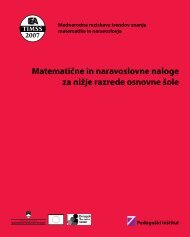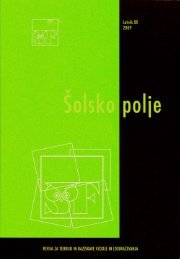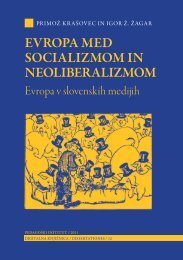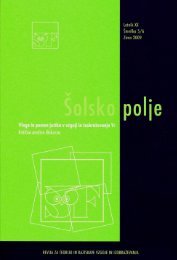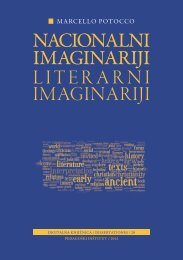124<strong>Umetnost</strong> v <strong>realnosti</strong>cidate that the above mentioned Benjamin’s essay represents an epistemologicalbreakthrough within the context of his writing and outsidethis of context too. There was a change in the aesthetic perception of artin the 1960s and 1970s. That was the time, when so called modernityreached its peak, and when it became possible to articulate very transparentlythat many barriers between “fine” and commercial art had fallen.Although the first such theoretical perceptions had been formulatedand elaborated much earlier (most outstandingly by Walter Benjaminand later on, among others, by Jean Francois Lyotard ) it can be argued,that before the mentioned period the theory of mass culture hadnot any decisive impact on the artistic production and vice versa. Enteringthe mass perception, the new forms of aesthetic praxis overturnedwhole functioning of the arts in the social imaginary. Although discussingthe problems of the form of aesthetic objects (products of “technological”arts included) may still be a “noble” task of aesthetic theory,there is no doubt that artistic production interferes into the reproductionof the society in much more decisive way than anybody everhad dreamt before. However, the complex meaning of this transformation,which is inscribed into the sociological notion of “reflexive society,”is still open for exploration. Reconsiderations of relations betweenaesthetic and artistic praxis and social changes from the viewpoint ofhegemony in its intellectual and political significations, enable deconstructiveinsights in the modernity’s achievements such as, for example,Antonioni ’s films, Warhol ’s ‘statements,’ or fashion styles.The understanding of intellectual habitus can be expressed only reflexively.It is necessarily caught in the coordinates of memory in a relationto a historical disposition. It is – if we are not about to tell everythingat once – pronounceable in the grammars of individual. All this ismanifested in Benjamin ’s attempts to think urbanity over in his relativelyordered essays about Baudelaire, as well as in his muddled and probablyfor ever semiotically open “Arcades.” Why are urbanity and intellectualitybound together as agencies in human community? Reflexivityisn’t just a concept since it is marking the expansion of industrial worldand social organisation, which exempts an individual from tradition –also by educating and “cultivating” him/her. Tremendously unique Benjamin’stexts describe urban spaces, as well as mass perception of architecture,and they decipher urbanity through poetry. Benjamin succeededin his endeavour above all because his texts speak the language of urbanity.Simultaneously, we could not ascribe to Benjamin that he wasidealising urbanity, or, considering his appropriation of Baudelaire’s po-
Summaryetry as a vocabulary of his city reading, that he has been censuring urbanityin some of its not so much aesthetic aspects. On the contrary:departing from Benjamin we in the start agree about inherent relationof urbanity and the intellectual habitus, at least from the beginnings ofthe age, which is delineated by the term of modernity. Something musthave been contained in his discourse, what made it a topic of big interestonly long time after it was written, and almost 30 years after the author’stoo early death. In the book we try to explain that this “something” isprecisely the reflexive moment, in which the intellectuality is visible asthe agency of the very notion of space in a city. Of course, already withBenjamin we know that, considering the intellectual habitus – regardlessof the fact that in his times it had not been denoted with this utterance– we have to deal with a mutual relationship. Out of it emerges theindividual, who we find on the spot, where we would like to think theSubject. From this point of view a comprehension of intellectual habituscould be revealed to us as it is visible also through lenses of cameras ofFrancois Truffaut, Woody Allen and Boštjan Hladnik. On the level ofan intellectual within mass culture it is in fact obvious that an intellectualis involved in production, that he/she is in the process of exchanginghis/her labour power for wages, for royalties and the like. Woody Allen’scontribution is not in that it shows only this, but that in the field offunctions of production he reduces intellectual production to its commondenominator. In the film Manhattan (1970) this denominator isliterally staged on the surface, behind which there is nothing hidden.Urban settlement is always organized as a concentrated social space,whose sociality is expressed in the real within the symbolic, which is reflectedin the city maps that are an illustration of intelligibility and cognitivnessof space. Art festivals are an indispensable attribute of the verynotion of a bigger city. In the age of globalisation festivals are – even ifthey represent something totally local – at least potentially an internationalevent for the sake of performers or for the sake of public, or justfor the sake of attention of media, which always go after newness. Obviously,some festivals are on the top of a kind of hierarchy of festivals andit doesn’t look like that they are eager to transfer their privileged positionsto other cities. However, this does not mean that other cities couldnot have quality festivals. But it is more or less clear that in all probabilitythey cannot overtake the primacy of famous renaissance centres.Dada’s efforts, which targeted an awakening of public indignation,has succeeded more and above all gruesomely differently than Dada artiststhemselves expected and imagined. The repression of the art, which125
- Page 1:
DAR KO ŠTR AJNUMETNOSTV REALNOSTIP
- Page 6 and 7:
Darko Štrajn, Umetnost v realnosti
- Page 8 and 9:
8Umetnost v realnostiIllusio kot na
- Page 16 and 17:
16Umetnost v realnostimatičnost, p
- Page 18 and 19:
18Umetnost v realnostitja, namreč
- Page 20 and 21:
20Umetnost v realnostikonsekvenc, t
- Page 22 and 23:
22Umetnost v realnostiknadno. Skrat
- Page 24 and 25:
24Umetnost v realnostiZa razliko od
- Page 27 and 28:
Valovi recepcijeBenjamina 127Zgodov
- Page 29 and 30:
Valovi recepcije Benjaminazdružuje
- Page 31 and 32:
Valovi recepcije Benjamina31Preden
- Page 33 and 34:
Valovi recepcije Benjaminaznati, da
- Page 35 and 36:
Valovi recepcije BenjaminaNa samem
- Page 37:
Valovi recepcije Benjaminagnila pot
- Page 40 and 41:
40Umetnost v realnostiNekoč je bil
- Page 42 and 43:
42Umetnost v realnostiersatz muzej
- Page 44 and 45:
44Umetnost v realnostiuživa danes.
- Page 46 and 47:
46Umetnost v realnostijo« dekonstr
- Page 48 and 49:
48Umetnost v realnostinejšega, rec
- Page 50 and 51:
50Umetnost v realnostipodročij na
- Page 52 and 53:
52Umetnost v realnostipolje kulture
- Page 55:
55Umetnost v realnostiII Urbani amb
- Page 58 and 59:
58Umetnost v realnostiljij razlikuj
- Page 60 and 61:
60Umetnost v realnostiNajbrž ni tr
- Page 62 and 63:
62Umetnost v realnostiavtor ni imel
- Page 64 and 65:
64Umetnost v realnostise je vzposta
- Page 66 and 67:
66Umetnost v realnostita, ki pouču
- Page 68 and 69:
68Umetnost v realnostialca v družb
- Page 70 and 71:
70Umetnost v realnosti❙ 5Madison
- Page 72 and 73:
72Umetnost v realnostiga in hkrati
- Page 74 and 75: 74Umetnost v realnostiobliki določ
- Page 77 and 78: Elitna množičnakultura 177Spontan
- Page 79 and 80: Elitna množična kulturastopajoči
- Page 81 and 82: Elitna množična kulturaKar smo re
- Page 83: Elitna množična kulturamive prime
- Page 86 and 87: 86Umetnost v realnosti❙ 6J. Goebb
- Page 88 and 89: 88Umetnost v realnostivzeta v kultu
- Page 91: 91Umetnost v realnostiIII Dogodek?
- Page 94 and 95: 94Umetnost v realnosti❙ 7Prizor i
- Page 96 and 97: 96Umetnost v realnostidigmo za to r
- Page 98 and 99: 98Umetnost v realnostilovito deklar
- Page 100 and 101: 100Umetnost v realnostijala posebni
- Page 102 and 103: 102Umetnost v realnostitudi še vrs
- Page 104 and 105: 104Umetnost v realnostilesa, o njeg
- Page 106 and 107: 106Umetnost v realnostičajna kmeč
- Page 108 and 109: 108Umetnost v realnostiveniji prejk
- Page 110 and 111: 110Umetnost v realnosti❙ 8Skupina
- Page 112 and 113: 112Umetnost v realnostiLaibach je g
- Page 114 and 115: 114Umetnost v realnostisplicitno go
- Page 116 and 117: 116Umetnost v realnostiZDA), kar la
- Page 118 and 119: 118Umetnost v realnostiČe je Laiba
- Page 120 and 121: 120Umetnost v realnostibil čas, ko
- Page 122 and 123: 122Umetnost v realnostinekakšnega
- Page 126 and 127: 126Umetnost v realnostiwas ideologi
- Page 129 and 130: Literatura129Alexander, Jeffrey C.
- Page 131: LiteraturaLyotard, Jean- Francois.
- Page 134 and 135: 134Umetnost v realnostiDdadaizem 36
- Page 136: 136Umetnost v realnostiRecki, Birgi





